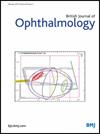Atropine and Spectacle lens Combination Treatment (ASPECT): 12-month results of a randomised controlled trial for myopia control using a combination of Defocus Incorporated Multiple Segments (DIMS) lenses and 0.025% atropine.
IF 3.5
2区 医学
Q1 OPHTHALMOLOGY
引用次数: 0
Abstract
AIM To evaluate and compare the efficacy of combination treatment using 0.025% atropine and Defocus Incorporated Multiple Segments (DIMS) spectacle lenses to 0.025% atropine and single vision (SV) spectacle lenses in slowing myopia progression in children with myopia. METHODS Randomised controlled trial conducted on children aged 4-16 years with myopia between -1.00D and -6.00D and astigmatism ≤2.00D. Children were randomly allocated into two groups: 0.025% atropine and SV spectacle lenses treatment group (group A), and 0.025% atropine and DIMS spectacle lenses treatment group (group B). Cycloplegic spherical equivalent refraction (SER) and axial length were measured at baseline, 6 and 12 months. RESULTS 102 patients completed the 12-month follow-up: n=49 in group A, mean age 9.50±2.78 years and n=53 in group B, mean age 9.90±2.47 years. At 12 months, the mean AL±SD change was 0.18±0.16 mm in group A and 0.07±0.16 mm in group B (mean difference: 0.11, 95% CI: 0.05 to 0.17; p≤0.001). Mean SER±SD progression at 12 months was -0.19±0.42D and -0.09±0.35D in groups A and B, respectively (p=0.13). 39.6% of children in group B had no axial elongation over 12 months compared with 12.2% of the children in group A (p=0.002). CONCLUSIONS Combination treatment with 0.025% atropine and DIMS spectacle lenses is more effective in controlling axial elongation than 0.025% atropine with SV lenses. Although not significant, SER differences between groups were lower in group B. These findings support a potential additive effect of the two treatments.阿托品和眼镜镜片联合治疗(ASPECT):一项为期12个月的随机对照试验结果,使用散焦合并多段(DIMS)镜片和0.025%阿托品联合治疗近视。
目的评价并比较0.025%阿托品联合离焦多节段(DIMS)镜片与0.025%阿托品联合单视力(SV)镜片在减缓近视儿童近视进展中的疗效。方法对4 ~ 16岁近视-1.00 ~ -6.00D,散光≤2.00D的儿童进行随机对照试验。将患儿随机分为两组:0.025%阿托品加SV镜片治疗组(A组)和0.025%阿托品加DIMS镜片治疗组(B组)。在基线、6个月和12个月时测量单眼瘫痪患者的球等效屈光度(SER)和眼轴长度。结果102例患者完成12个月的随访:A组49例,平均年龄9.50±2.78岁;B组53例,平均年龄9.90±2.47岁。12个月时,A组平均AL±SD变化为0.18±0.16 mm, B组平均AL±SD变化为0.07±0.16 mm(平均差为0.11,95% CI: 0.05 ~ 0.17;p≤0.001)。A组和B组12个月时SER±SD平均进展分别为-0.19±0.42D和-0.09±0.35D (p=0.13)。39.6%的B组患儿在12个月内无轴向伸长,而A组患儿为12.2% (p=0.002)。结论0.025%阿托品与DIMS镜片联合使用比0.025%阿托品与SV镜片联合使用更有效地控制眼球轴伸长。虽然不显著,但组间SER差异在b组较低。这些发现支持两种治疗的潜在叠加效应。
本文章由计算机程序翻译,如有差异,请以英文原文为准。
求助全文
约1分钟内获得全文
求助全文
来源期刊
CiteScore
10.30
自引率
2.40%
发文量
213
审稿时长
3-6 weeks
期刊介绍:
The British Journal of Ophthalmology (BJO) is an international peer-reviewed journal for ophthalmologists and visual science specialists. BJO publishes clinical investigations, clinical observations, and clinically relevant laboratory investigations related to ophthalmology. It also provides major reviews and also publishes manuscripts covering regional issues in a global context.

 求助内容:
求助内容: 应助结果提醒方式:
应助结果提醒方式:


